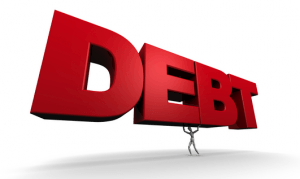Ghana’s public debt rises above 78% of GDP, and Bank of Ghana keeps policy rate unchanged
 Ghana’s public debt keeps rising with no end in sight, with the current figure of GH¢344.5 billion as at the end of November 2021 representing 78.4 per cent of GDP, according to the Bank of Ghana.
Ghana’s public debt keeps rising with no end in sight, with the current figure of GH¢344.5 billion as at the end of November 2021 representing 78.4 per cent of GDP, according to the Bank of Ghana.
The debt to GDP ratio was 76 per cent of GDP at the end of December 2020, totalling GH¢291.6 billion.
“Of the total debt stock, domestic debt was GH¢179.4 billion (40.8 percent of GDP), while the external debt was GH¢165.1 billion (37.6 percent of GDP),” the Bank said in a press release copied to Ghana Business News.
The Bank after the 104th and first meeting its Monetary Policy Committee in 2022, last week, decided to keep the policy rate unchanged at 14.5 per cent.
According to the Bank, the economy has continued its strong recovery from the COVID-related economic downturn.
Citing the latest Ghana Statistical Service update, it said Real GDP growth for the first three quarters of 2021 averaged 5.3 per cent, compared with an average contraction of 0.6 per cent recorded in the same period of 2020.
Similarly, non-oil GDP growth averaged 6.9 per cent against a contraction of 0.3 per cent over the same comparative period. Overall, GDP growth for 2021 is projected to exceed the target of 4.4 per cent, it added.
The Bank indicates that its latest confidence surveys conducted in December 2021 signalled mixed sentiments. While consumer confidence softened because of recent increases in ex-pump petroleum prices and the announcement of new tax measures in the 2022 budget, business sentiments, on the other hand improved, it said.
It states further that the improved business sentiments were driven by the achievement of short-term company targets and optimism about companies’ growth prospects.
“In addition, the Ghana Purchasing Managers Index (PMI), which gauges the rate of inventory accumulation by managers of private sector firms and which measures dynamics in economic activity, increased for four consecutive months in the second half of 2021—a development which is consistent with the observation of a steady increase in economic activity,” it said.
On inflation, the central bank notes that, after falling to 7.5 per cent in May 2021, it increased throughout the second half of the year, ending December 2021 at 12.6 per cent. Non-food inflation went up from 9.2 per cent in May 2021 to 12.5 per cent in December 2021 while food inflation, over the same period rose sharply, moving from 5.4 per cent in May 2021 to 12.8 per cent in December 2021, it said.
According to the Bank, the upward trajectory of inflation in the second half of 2021 reflected food supply challenges, rising crude oil prices, and some pass-through effects of exchange rate depreciation in the last quarter. At 12.6 per cent for December 2021, headline inflation had moved outside the upper band of the medium-term target by 2.6 per cent, it said.
It notes that, in line with the increases in headline inflation, underlying inflationary pressures, measured across all the Bank’s core measures of inflation, also increased over the period. The main core inflation measure, which excludes energy and utility, increased from 7.3 per cent in May 2021 to 11.8 per cent in December 2021.
In addition, the weighted inflation expectations index, which captures inflation sentiments of consumers, businesses, and the financial sector, also picked up significantly in December 2021, the Bank added.
By Emmanuel K. Dogbevi
Copyright ©2022 by NewsBridge Africa
All rights reserved. This article or any portion thereof may not be reproduced or used in any manner whatsoever without the express written permission of the publisher except for the use of brief quotations in reviews.
